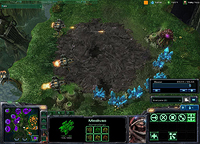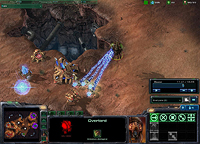Game Guide: Zerg: Basics
Basic Production
The zerg produce their workers and units from the same place: a structure called a hatchery. Hatcheries spawn larvae over time, and these larvae morph into various zerg units. The more hatcheries you have, the more larva you have available, and the more units you can produce. Other structures, such as the spawning pool or roach warren, only give you the ability to morph larva into units. They do not actually produce units themselves, unlike the facilities that protoss or terran use. Learn more about hatcheries.
Rally Points
Zerg hatcheries have two rally points: one for worker units (drones), and another for non-worker units. Right-clicking on a mineral cluster or vespene geyser will cause newly hatched drones to head towards it and begin gathering resources. Right-clicking elsewhere on the map (on the ground, a building, or a unit, for example) will cause non-worker units to move to that location as soon as they are spawned. If you want to rally drones somewhere else on the map besides a resource node, press the G key and left-click.
Health Regeneration
Perhaps the greatest advantage of zerg biology is an amazing regenerative ability.
The zerg ability to regenerate health makes retreating from battle extremely viable. Should your units get damaged during a fight, retreat and use a new force to press the attack while the injured force heals. By cycling between two major forces and healing between attacks, you'll save time and money – you can bolster your forces with newly produced units rather than replacing dead ones. To further protect injured units while they heal, use the burrow ability to keep them out of the enemy's sight.
The queen unit also has the ability to heal buildings and units with the transfusion ability, which instantly restores health to one target.
Overlords
Unlike supply for protoss and terran armies, zerg supply is provided by a unit – the overlord – rather than by a structure. The overlord can fly around the map slowly (and quickly, after being upgraded), and it can be upgraded to transport units like a dropship or drop creep onto the map. Because overlords are available so early and required in large numbers, zerg players frequently use them as early scouts to provide a complete picture of the map.
Because overlords are flying units and useful scouts, zerg armies are particularly vulnerable to losing their unit supply to attacks on their overlords. If you find yourself unable to create new units due to the death of your overlords, you will have to produce new overlords and raise your amount of unit supply. You might hide your overlords to reduce the chances of them being killed, or place them all over the map so they’re harder to track down quickly.
 3 vikings chase down overlords. |
 4 protoss sentries target an overlord. |
|
Protect your Spawning Pool
Since your spawning pool allows for the creation of several key units, you should consider placing it in a hard to reach spot (such as behind your mineral clusters). When an opponent attacks your base, it should be as difficult as possible for them to reach and destroy your most crucial structures.
Drone Escape
If one of your drones is about to die, morph it into an extractor (a structure that allows the collection of vespene gas), then cancel the extractor's construction once your enemy has left to save the drone.
Bonus Drones
In the event that you’d like to build two drones over the supply limit, simply build two extractors, then two drones, and then immediately cancel both extractors. The drones that morphed into extractors will remain.
Creating Units
Most zerg units are created by morphing larva at the hatchery (or lair/hive). The queen is independently created at the hatchery (you do not need to morph larva into a queen). Additionally, a few zerg units are created by morphing other zerg units:
Overlord -> Overseer
Zergling -> Baneling
Corruptor -> Brood Lord
And a few zerg units are spawned by other zerg units:
Infestor -> Infested Terrans
Overseer -> Changeling
Brood Lord -> Broodling
Building Death -> Broodling